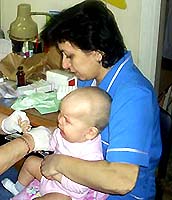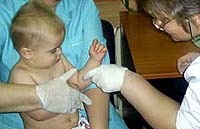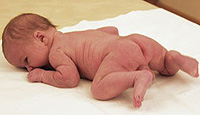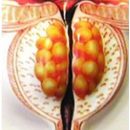Signs of Hunter syndrome change widely from the patient to the patient. In addition to possible problems with the heart, light, liver and other bodies, the musculoskeletal apparatus and brain lesions, many with Hunter syndrome are experiencing more pain than ordinary people.
Content
Signs of Hunter syndrome change widely from the patient to the patient. In addition to possible problems with the heart, light, liver and other bodies, the musculoskeletal apparatus and brain lesions, many with Hunter syndrome are experiencing more pain than ordinary people. Often due to thicker and rigid skin there are difficulties with access to veins and blood intake for laboratory tests. This article outlines useful proposals on how to facilitate these procedures and reduce pain associated with them. Some of these recommendations were successfully used during elaprase infusion procedures in the Children's Hospital and the Research Center in Auckland.
Pain is an unpleasant sensory and emotional feeling associated with real or potential damage to the tissue, or described in the concepts of such damage. In other words, nurses and doctors must listen to every person and their opinion about pain. The pain is real and measures should be taken against it.
Procedural pain
 Procedural pain has a short duration and is associated with interventional treatment or diagnostic tests, such as the introduction of the needle to Vienna through the skin or lumbar puncture. If a painful procedure is planned, the medical staff should explain that pain should only last for a short time.
Procedural pain has a short duration and is associated with interventional treatment or diagnostic tests, such as the introduction of the needle to Vienna through the skin or lumbar puncture. If a painful procedure is planned, the medical staff should explain that pain should only last for a short time.
People with Hunter syndrome, the needles of the needle in Vienna or the take of blood tests can be required much more often than ordinary people. For example, when the needle is introduced into Vienna, it takes much more often than the usual when obtaining intravenously antibiotics or during surgical operations.
Preparation for the procedure is important for children and patients with mental delay. Game therapy can be a valuable tool for children, often experiencing procedural pain.
People often encountered painful pain, often have stronger behavioral and physical reactions due to the concern that it will happen. If you do not work with a child over his fears and perception of pain, it is likely that it will suffer further from excessive voltage and temporary behavioral changes.
Pain assessment
It is desirable that the doctor or nurse know how a child reacts to pain. It is very important that parents bring this information to them. Most clinics are in their «Arsenale» Special Pain Diffmeses, such as the FLACC scale, designed for young children, Evaluation Scale of Wong Baker's pain, as well as digital 10-point (from 0 to 10 points) Pain estimation scale.
Physical signs that may show that a person is painful is a rapid heartbeat, elevated blood pressure, deeper or rapid breathing, sweating and pale color. However, even in the absence of these signs there is no guarantee that a person does not experience pain. Change in behavior (change in facial expression, restlessness, attracting attention behavior, cry or crying) is usually observed over a short period of time when pain occurs and often quickly disappears after the source of pain. Long-term inconsistent pain may cause anxiety, irritability, depression, fatigue.
Prevent or reduce pain
With moderate pain, it is recommended to take moderate analgesics of type acetaminophen or anti-inflammatory non-steroids of ibuprofenic preparations. With a stronger pain, a combination of moderate analgesics and a stronger opioid (stronger anti-hare preparations) is recommended. With the introduction of needles in Vienna and the blood fence, local anesthesia can be used successfully. Anesthetic gel helps with local «nod» Pain, but cannot help with procedures affecting deeper tissues, for example, with lumbar punclases. Anesthetic gel should not be used with rash or skin damage. It cannot be used for babies that appeared on the light in premature birth (less than 38 weeks). It is important to follow the recommendations for the use of drugs - the beginning and duration of the drug, its applicability for a particular procedure.
 Some non-medical procedures also allow to significantly reduce pain. Warming up hands or legs with a warm blanket or hot water improves intravenous access, especially in the cold season. Abundant drinking day before the procedure and the adoption of diuretic products immediately in front of it improves blood circulation, facilitating intravenous access.
Some non-medical procedures also allow to significantly reduce pain. Warming up hands or legs with a warm blanket or hot water improves intravenous access, especially in the cold season. Abundant drinking day before the procedure and the adoption of diuretic products immediately in front of it improves blood circulation, facilitating intravenous access.
In some cases, it is necessary to make some preventive procedures directed, for example, to eliminate nausea or diarrhea. This will help the patient relax, improve blood circulation and reduce its anxiety.
Some patients are significantly better to transfer the procedure if smaller needles apply. This is primarily due to the fact that the skin of people with Hunter syndrome is tougher.
It is important to ensure a calm and soft atmosphere. If the patient is very worried, it can be hugged. It will calm down the child and will help limit him in movements. You can use all sorts of distracting tools - television, video, toys. Praise for patience and a small reward after completion of the procedure for a long time to remember the child and strongly shade unpleasant painful experience in his mind.
It is important to limit the number of attempts to a maximum of three. It is very important to have trust relationships with the patient. The clinic may have a lot of excellent procedures for intravenous access procedures, but usually only a limited range of specialists is able to successfully conduct a specific child procedure.
If the patient has intravenous access is very difficult, and it requires repeated procedures, it may be shown permanent central venous access, for example, with the help of the Silicon system Port-A-Cath.
If the needle insert has passed successfully, it is necessary to take steps to prevent its accidental loss. The needle must be fixed by sticking ribbon and bandage. Very effective fixation of hoses and tubes to patient clothes with sticky tape. In addition, it is necessary at least the hourly observation of areas of the skin, where the needle was introduced - may be the appearance of red, bloating or pain.
Termination of intravenous procedure for any child can be frightening and painful. In some patients, there may be supersensitive skin, which is why the needle seizure and especially removal of the tape can be very painful. It was found that the lubrication of the skin area with water or oil reduces pain.
Effective struggle with pain increases comfort, health, and quality of patient life. Need to eliminate or reduce pain, reduce anxiety. It is important to remember that pain perception is very individual. Doctor and family must work with each patient. Communication, training, empathy will greatly facilitate the procedure.









